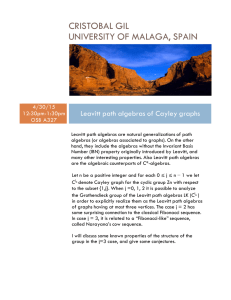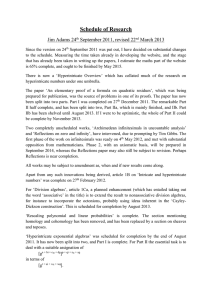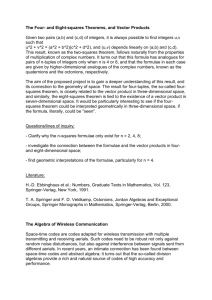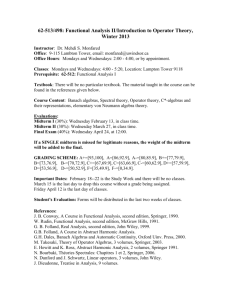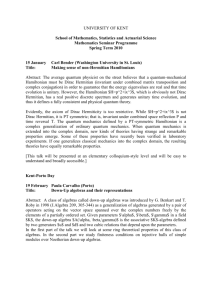Infinitesimal Cherednik Algebras of gl 2 David Ding, Sasha Tsymbaliuk
advertisement
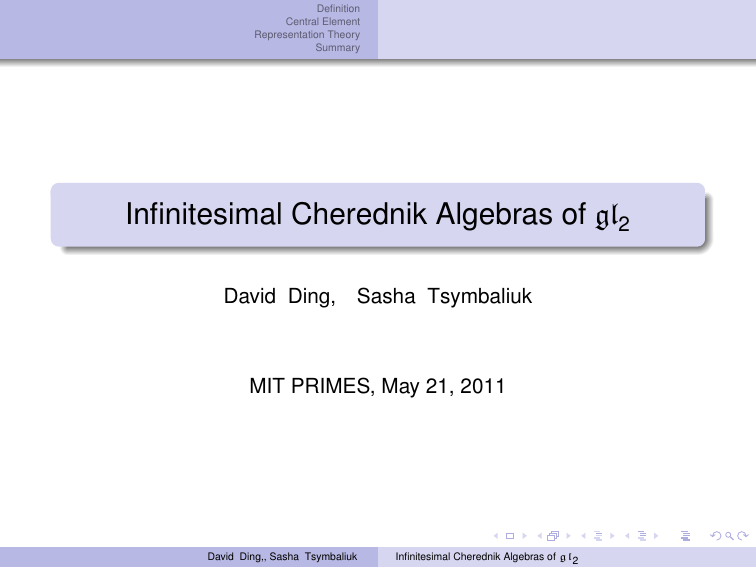
Definition
Central Element
Representation Theory
Summary
Infinitesimal Cherednik Algebras of gl2
David Ding,
Sasha Tsymbaliuk
MIT PRIMES, May 21, 2011
David Ding,, Sasha Tsymbaliuk
Infinitesimal Cherednik Algebras of gl2
Definition
Central Element
Representation Theory
Summary
Introduction
Main object: Infinitesimal Cherednik algebras Hc .
Questions:
1
2
3
Algebraic structure of these algebras?
Generalization of the basic theory of sln+1 representation?
What is happening in nonzero characteristic?
Results:
1
2
3
4
Explicit computation of the center of Hc
Computation of the Shapovalov form
Irreducibility criterion of Verma modules
Classification of irreducible finite dimensional representations
David Ding,, Sasha Tsymbaliuk
Infinitesimal Cherednik Algebras of gl2
Definition
Central Element
Representation Theory
Summary
Introduction
Main object: Infinitesimal Cherednik algebras Hc .
Questions:
1
2
3
Algebraic structure of these algebras?
Generalization of the basic theory of sln+1 representation?
What is happening in nonzero characteristic?
Results:
1
2
3
4
Explicit computation of the center of Hc
Computation of the Shapovalov form
Irreducibility criterion of Verma modules
Classification of irreducible finite dimensional representations
David Ding,, Sasha Tsymbaliuk
Infinitesimal Cherednik Algebras of gl2
Definition
Central Element
Representation Theory
Summary
Introduction
Main object: Infinitesimal Cherednik algebras Hc .
Questions:
1
2
3
Algebraic structure of these algebras?
Generalization of the basic theory of sln+1 representation?
What is happening in nonzero characteristic?
Results:
1
2
3
4
Explicit computation of the center of Hc
Computation of the Shapovalov form
Irreducibility criterion of Verma modules
Classification of irreducible finite dimensional representations
David Ding,, Sasha Tsymbaliuk
Infinitesimal Cherednik Algebras of gl2
Definition
Central Element
Representation Theory
Summary
Associative and Lie algebras
An associative algebra is a vector space with an associative and
distributive multiplication.
A Lie algebra is a vector space with a bilinear anti-symmetric Lie
bracket [a, b] that satisfies the Jacoby identity:
[[a, b], c] + [[b, c], a] + [[c, a], b] = 0
If A is an associative algebra, then we can define a Lie algebra
structure on A by [a, b] = ab − ba for a, b ∈ A.
If g is a Lie algebra, we use Ug to denote its universal enveloping
algebra so that [g1 , g2 ] = g1 g2 − g2 g1 for g1 , g2 ∈ g
Examples of Lie algebras: gln and sln .
David Ding,, Sasha Tsymbaliuk
Infinitesimal Cherednik Algebras of gl2
Definition
Central Element
Representation Theory
Summary
Definition of Infinitesimal Cherednik Algebras
We will abbreviate gln by g.
Definition
Let V be the standard n-dimensional column representation of g, and
V ∗ be the row representation, c : V × V ∗ → Ug.
The infinitesimal Cherednik algebra Hc is defined as the quotient of
Ug n T (V ⊕ V ∗ ) by the relations:
[y , x] = c(y , x), [x, x 0 ] = [y , y 0 ] = 0
for all x, x 0 ∈ V ∗ and y , y 0 ∈ V .
David Ding,, Sasha Tsymbaliuk
Infinitesimal Cherednik Algebras of gl2
Definition
Central Element
Representation Theory
Summary
Acceptable deformations c
We are only interested in those Hc that satisfy the PBW property:
grHc = H0 = U(g n (V ⊕ V ∗ ))
Etingof, Gan, and Ginzburg proved that Hc satisfies the PBW
Pk
property if and only if c is given by j=0 αj rj where rj is the
coefficient of τ j in the expansion of
(x, (1 − τ A)−1 y ) det(1 − τ A)−1
David Ding,, Sasha Tsymbaliuk
Infinitesimal Cherednik Algebras of gl2
Definition
Central Element
Representation Theory
Summary
Center is Polynomial Algebra
Tikaradze proved that there exist g1 , g2 ∈ z(Ug) so that
z(Hc ) = k [t1 + g1 , t2 + g2 ]
| {z } | {z }
t10
t20
t1 and t2 are generators for the center of H0 .
z(Ug) is a polynomial algebra in β1 and β2
c = r0 = (y , x)
t10 = t1 + β1 , t20 = t2 + β2
c = r1 = β1 (y , x) + y ⊗ x
t10 = t1 + β12 − β2 − 32 β1 , t20 = t2 + β1 β2 − 32 β2 − 41 β1
David Ding,, Sasha Tsymbaliuk
Infinitesimal Cherednik Algebras of gl2
Definition
Central Element
Representation Theory
Summary
sm
Definition
Let γ = β12 − 4β2 + 1. Define sm = Am (y , x) + Bm y ⊗ x, with
Am
bm+2
j−1
2 cX
1 X
4j − m − 1 m + 2
m + 1 − 2k m+2−2j k
= m+1
β
γ
2
2j + 1
2k + 1 2j − 2k − 1 1
j=1 k =0
bm+1
2 c j−1
Bm
2j
1 X X m+2
β m+1−2j γ k
= m
2j + 1 2k + 1 1
2
j=1 k =0
Theorem
The algebras Hc satisfy the PBW property if and only if c =
David Ding,, Sasha Tsymbaliuk
Infinitesimal Cherednik Algebras of gl2
P
j
aj sj .
Definition
Central Element
Representation Theory
Summary
Examples
s0 = (y , x) = r0
s1 = β1 (y , x) + y ⊗ x = r1
s2 = 21 1 + γ + β12 (y , x) + 2β1 y ⊗ x = r2 + r0
s3 = γ(β1 + 1) (y , x) + 21 1 + γ + 5β12 y ⊗ x
1
s4 = 16
3 + 10γ + 3γ 2 + 18β12 + 18γβ12 − 5β14 (y , x) +
1
2
2 β1 3 + 3γ + 5β1 y ⊗ x
David Ding,, Sasha Tsymbaliuk
Infinitesimal Cherednik Algebras of gl2
Definition
Central Element
Representation Theory
Summary
Center of Hc
Define
g10 (m)
g20 (m)
=
=
1
2m+1
1
2m+2
b m+2
2 c
j X X
m+2
2j + 1
β m+1−2j γ k
2j + 1 2k + 1 1
j=0 k =0
m+2
m + 1 − 2k m+2−2j k
−
β
γ
2k + 1 2j − 2k − 1 1
b m+2
2 c
j
X X
m − 2j − 2k + 1 m + 2 m + 2 − 2k m+1−2j k
β1
γ
2k + 1
2k
2j − 2k
j=0 k =0
m + 1 − 2k m+2−2j k
2j + 2k − m m + 2
β1
γ
−
2j − 2k + 1 2k + 1
2j − 2k
David Ding,, Sasha Tsymbaliuk
Infinitesimal Cherednik Algebras of gl2
Definition
Central Element
Representation Theory
Summary
Center of Hc
Theorem
For a deformation c =
P
i
ai si , the center z(Hc ) = k [t10 , t20 ], with
t10 = t1 +
X
ai g10 (i)
t20 = t2 +
X
ai g20 (i)
David Ding,, Sasha Tsymbaliuk
Infinitesimal Cherednik Algebras of gl2
Definition
Central Element
Representation Theory
Summary
Center of Hc
Theorem
For a deformation c =
P
i
ai si , the center z(Hc ) = k [t10 , t20 ], with
t10 = t1 +
X
ai g10 (i)
t20 = t2 +
X
ai g20 (i)
For c = s0 , t10 = t1 + β1
t20 = t2 − 14 γ + 41 β12
For c = s1 , t10 = t1 + β12 − β2 − 32 β1
t20 = t2 − 14 β1 γ + 83 γ + 14 β13 − 38 β12
For c = s2 , t10 = t1 + 12 (β1 γ − γ + β13 − 3β12 + 3β1 )
1 2
t20 = t2 − 38 γ − 16
γ + 12 γβ1 + 38 β12 − 18 γβ12 − 21 β13 +
David Ding,, Sasha Tsymbaliuk
3 4
16 β1
Infinitesimal Cherednik Algebras of gl2
Definition
Central Element
Representation Theory
Summary
Isomorphism with U(sln+1 )
There is an isomorphism φ : Hc → U(sln+1 ) for the infinitesimal
Cherednik algebra of gln , when c = a0 s0 + a1 s1 , with a1 6= 0:
= α , for α ∈ sln
1
φ(yi ) = √ ei,n+1
a1
1
φ(xi ) = √ en+1,i
a1
a0
1
e11 + e22 + ... + enn − n en+1,n+1 −
φ(β1 ) =
n+1
a1
φ(α)
David Ding,, Sasha Tsymbaliuk
Infinitesimal Cherednik Algebras of gl2
Definition
Central Element
Representation Theory
Summary
Representation Theory
Definition
A representation of an algebra A is a vector space V with an
action of A defined on it.
V is irreducible if it has no non-trivial A-invariant subspaces.
Representation theory of sln :
Consider the triangular decomposition sln into sln = n+ ⊕ n− ⊕ h.
An important representation of sln is the Verma module,
generated by an eigenvector of h on which n+ acts by 0.
All "nice" irreducible representations of sln are quotients of some
Verma module by its maximal submodule.
David Ding,, Sasha Tsymbaliuk
Infinitesimal Cherednik Algebras of gl2
Definition
Central Element
Representation Theory
Summary
Verma Module of Hc
Notate the matrix with one on the i-th row and j-th column by eij
and the standard bases of V and V ∗ by yi and xi respectively.
Let U(n+ ), U(n− ), and U(h) be subalgebras of Hc generated by
{e12 , y1 , y2 }, {e21 , x1 , x2 }, and {e11 , e22 } respectively.
Since the PBW property holds, we can write
Hc = U(n− ) ⊗ U(h) ⊗ U(n+ ).
For a weight λ ∈ h∗ , define the Verma module as
M(λ) = Hc /{Hc n+ + Hc (h − λ(h))}
David Ding,, Sasha Tsymbaliuk
Infinitesimal Cherednik Algebras of gl2
Definition
Central Element
Representation Theory
Summary
Shapovalov Form
Define the Harish Chandra projection HC : Hc → Uh with respect
to the decomposition Hc = Uh ⊕ (Hc n+ + (n− )Hc )
Define σ : Hc → Hc to be the anti-involution with σ(e12 ) = e21 ,
σ(yi ) = xi , σ(eii ) = eii .
Definition
The Shapovalov form S : Hc × Hc → Uh is given by
S(a, b) = HC(σ(a) b)
Its evaluation in λ ∈ h∗ is denoted by S(λ).
David Ding,, Sasha Tsymbaliuk
Infinitesimal Cherednik Algebras of gl2
Definition
Central Element
Representation Theory
Summary
Motivation for Shapovalov form
Theorem
1. S(U(n− )µ , U(n− )ν ) = 0 if µ 6= ν.*
2. The Verma module is irreducible iff det Sν (λ) 6= 0 for ν > 0.
*Thus, we can restrict the Shapovalov form without losing information.
By computing the determinant of the Shapovalov form, we can
find the irreducible Verma modules.
David Ding,, Sasha Tsymbaliuk
Infinitesimal Cherednik Algebras of gl2
Definition
Central Element
Representation Theory
Summary
Central elements action on Verma Module
Theorem
For a deformation c =
P(λ) =
X
P
i
ai si , t10 acts on M(λ) by
ai Pi+1 (λ1 + 1, λ2 ) =
i
X
i
ai
i+1
X
(λ1 + 1)j λ2i+1−j
j=0
and t20 by
X 1
ai
Pi+1 (λ1 + 1, λ2 ) + Pi+2 (λ1 + 1, λ2 ) − (λ1 + 1)m+2 − λm+2
2
2
i
David Ding,, Sasha Tsymbaliuk
Infinitesimal Cherednik Algebras of gl2
Definition
Central Element
Representation Theory
Summary
Shapovalov Determinant
Define the set of positive roots
∆+ = {αij : αij (h) = hi − hj , ∀h = diag(h1 , h2 , ..., hn ) ∈ h}i<j
Define the Kostant partition function τ as τ (ν) = dim U(n− )−ν
Theorem
The Shapovalov form is given by
det Sν =
∞
Y Y
(P(λ) − P(λ − n α))
τ (ν−n α)
α∈∆+ n=1
David Ding,, Sasha Tsymbaliuk
Infinitesimal Cherednik Algebras of gl2
Definition
Central Element
Representation Theory
Summary
Outline of Proof
1
If det Sν (λ) = 0, M(λ) has a highest weight vector of weight
λ − µ for some µ > 0. Since M(λ − µ) is embedded in M(λ), t10
acts on M(λ) and M(λ − µ) identically. Thus, the determinant
must be a product of factors of form P(λ) − P(λ − µ).
2
We then compute the highest term of the determinant, which is
the product of diagonal elements of the Shapovalov form. The
highest term tells us that the factors in the determinant
correspond to µ being a multiple of a simple root.
3
Finally, to compute the powers of each factor, we use Jantzen’s
technique: we consider M(λ + tρ) instead of M(λ). This t allows
us to keep track of the order of zero at any λ to verify the power
of each factor precisely matches that given by the formula.
David Ding,, Sasha Tsymbaliuk
Infinitesimal Cherednik Algebras of gl2
Definition
Central Element
Representation Theory
Summary
Outline of Proof
1
If det Sν (λ) = 0, M(λ) has a highest weight vector of weight
λ − µ for some µ > 0. Since M(λ − µ) is embedded in M(λ), t10
acts on M(λ) and M(λ − µ) identically. Thus, the determinant
must be a product of factors of form P(λ) − P(λ − µ).
When we are dealing with c = as0 , we must use t20 instead of t10
2
We then compute the highest term of the determinant, which is
the product of diagonal elements of the Shapovalov form. The
highest term tells us that the factors in the determinant
correspond to µ being a multiple of a simple root.
3
Finally, to compute the powers of each factor, we use Jantzen’s
technique: we consider M(λ + tρ) instead of M(λ). This t allows
us to keep track of the order of zero at any λ to verify the power
of each factor precisely matches that given by the formula.
David Ding,, Sasha Tsymbaliuk
Infinitesimal Cherednik Algebras of gl2
Definition
Central Element
Representation Theory
Summary
Outline of Proof
1
2
If det Sν (λ) = 0, M(λ) has a highest weight vector of weight
λ − µ for some µ > 0. Since M(λ − µ) is embedded in M(λ), t10
acts on M(λ) and M(λ − µ) identically. Thus, the determinant
must be a product of factors of form P(λ) − P(λ − µ).
We then compute the highest term of the determinant, which is
the product of diagonal elements of the Shapovalov form. If we
let α = (b1 , b2 ), this product equals
!τ (ν−nα)
∞
m+1
Y Y
X
i−1 m+1−i
i m−i
i b1 λ1 λ2
+ (m + 1 − i)b2 λ1 λ2
α∈∆+ n=1
3
i=0
The highest term tells us that the factors in the determinant
correspond to µ being a multiple of a simple root.
Finally, to compute the powers of each factor, we use Jantzen’s
technique: we consider M(λ + tρ) instead of M(λ). This t allows
us to keep track of the order of zero at any λ to verify the power
of each factor precisely matches that given by the formula.
David Ding,, Sasha Tsymbaliuk
Infinitesimal Cherednik Algebras of gl2
Definition
Central Element
Representation Theory
Summary
Outline of Proof
1
If det Sν (λ) = 0, M(λ) has a highest weight vector of weight
λ − µ for some µ > 0. Since M(λ − µ) is embedded in M(λ), t10
acts on M(λ) and M(λ − µ) identically. Thus, the determinant
must be a product of factors of form P(λ) − P(λ − µ).
2
We then compute the highest term of the determinant, which is
the product of diagonal elements of the Shapovalov form. The
highest term tells us that the factors in the determinant
correspond to µ being a multiple of a simple root.
3
Finally, to compute the powers of each factor, we use Jantzen’s
technique: we consider M(λ + tρ) instead of M(λ). This t allows
us to keep track of the order of zero at any λ to verify the power
of each factor precisely matches that given by the formula.
David Ding,, Sasha Tsymbaliuk
Infinitesimal Cherednik Algebras of gl2
Definition
Central Element
Representation Theory
Summary
When is L(λ) finite dimensional?
Recall that L(λ) = M(λ)/M(λ).
First we show that L(λ) can be written as
n1
vλ + Hc x2n2 vλ + Hc x1n3 vλ }n3 <n1 or n3 =∞
L(λ) = M(λ)/{Hc e21
We follow the approach of T. Chmutova. First decompose
n1
vλ ), with vλ being the highest weight vector:
M(λ)/(Hc e21
Vn1 ⊕ (Vn1 ⊗ span(x1 , x2 )) ⊕ (Vn1 ⊗ span(x12 , x1 x2 , x22 )) ⊕ ...
Vn1 is the n1 -dimensional irreducible representation of gl2 .
We have span(x1 , x2 ) ∼
= V2 , span(x 2 , x1 x2 , x 2 ) ∼
= V3 , etc
1
2
Using Clebsh-Gordon formula, we can decompose further into
Vn1 ⊕ (Vn1 −1 ⊕ Vn1 +1 ) ⊕ ...
David Ding,, Sasha Tsymbaliuk
Infinitesimal Cherednik Algebras of gl2
Definition
Central Element
Representation Theory
Summary
A Picture of L(λ)
For n1 = 3, gl2 decomposes
3
vλ ) into
M(λ)/(Hc e21
V3 ⊕ (V2 ⊕ V4 ) ⊕ (V1 ⊕ V3 ⊕ V5 ) ⊕ ...
Arrows denote representations that can
be reached by the action of x1 or x2 .
The quotients by x1
and x24 are shown.
David Ding,, Sasha Tsymbaliuk
Infinitesimal Cherednik Algebras of gl2
Definition
Central Element
Representation Theory
Summary
A Picture of L(λ)
For n1 = 3, gl2 decomposes
3
vλ ) into
M(λ)/(Hc e21
V3 ⊕ (V2 ⊕ V4 ) ⊕ (V1 ⊕ V3 ⊕ V5 ) ⊕ ...
Arrows denote representations that can
be reached by the action of x1 or x2 .
This is an improper
quotient.
David Ding,, Sasha Tsymbaliuk
Infinitesimal Cherednik Algebras of gl2
Definition
Central Element
Representation Theory
Summary
Existance of Finite Dimensional L(λ)
This diagram show that L(λ) can be written as
n1
vλ + Hc x2n2 vλ + Hc x1n3 vλ }
L(λ) = M(λ)/{Hc e21
for n3 < n1 or n3 = ∞.
We showed that there exist some λ and some c so that this L(λ)
exists.
The dimension of L(λ) is
n2 n3 (2n1 + n2 − n3 )
2
for n3 < n1 and for n3 = ∞,
n2 n1 (n1 + n2 )
2
David Ding,, Sasha Tsymbaliuk
Infinitesimal Cherednik Algebras of gl2
Definition
Central Element
Representation Theory
Summary
Summary
We found a basis for PBW deformations and computed the
central elements in this basis. We showed that the action of the
center on the Verma module is particularly simple.
We computed the Shapovalov determinant and used it to find all
irreducible Verma modules and finite-dimensional L(λ).
Currently, we are trying to generalize our results to gln .
David Ding,, Sasha Tsymbaliuk
Infinitesimal Cherednik Algebras of gl2
Definition
Central Element
Representation Theory
Summary
Acknowledgments
My mentor, Sasha Tsymbaliuk, for guiding me through this
project
Professor Etingof for suggesting this question to us
The PRIMES program for providing this research opportunity
David Ding,, Sasha Tsymbaliuk
Infinitesimal Cherednik Algebras of gl2
